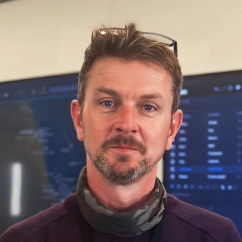Countdown to a renewables milestone
It’ll be the largest offshore wind farm the world has ever seen, powering the equivalent of six million British homes. And although all 277 turbines won’t be operational until 2026, excitement has been growing in the buildup to 10 October, when we announced first power. We paid a visit during that final, exciting phase.
Here, inside the landmark Operations and Maintenance base in Newcastle-upon-Tyne, all eyes are on the control room in the Marine Coordination Centre, where SSE Renewables, Vårgrønn and Equinor are overseeing its construction.
Once inside the secluded control room, we discover a calm that belies the sheer scale of the project before our eyes. Low voices and tapping of keys underpin the atmosphere of concentration.
Occasionally a maritime radio crackles into life — the only tangible evidence of a hive of activity taking place offshore.
Wall-sized computer screens show a giant jigsaw puzzle moving in real time – ships, helicopters, cable lays, turbines, and towers — and the nearly 500 people living and working far out at sea to assemble the pieces.
(Story continues below)










